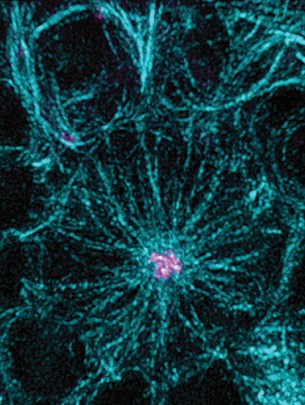Another Step in Understanding Microcephaly
Errors in the formation of neurons can lead to neurodevelopmental disorders such as microcephaly, an abnormally small brain. Prof. Clemens Cabernard’s team at the Biozentrum, University of Basel, has examined a protein that is involved in the development of microcephaly. As the scientists report in “Cell Reports”, this protein plays an important role in the cell division of neural stem cells and fulfills two very different tasks.
28 January 2016
The human brain consists of some 200 billion nerve cells. These develop from very few neural stem cells, which are the key to healthy brain development. Errors in stem cell division, caused by genetic defects, can lead to malformations such as microcephaly. The clinical picture is characterized by a reduced brain volume and mental retardation.
So far twelve genes and their proteins are known to be associated with the development of microcephaly. In neural stem cells of the fruit fly Drosophila melanogaster, so-called neuroblasts, the researchers led by Prof. Clemens Cabernard from the Biozentrum of the University of Basel have now investigated more closely one of these proteins, named Wdr62. It turned out that Wdr62 plays an important role in asymmetrical cell division as well as in brain development.
Neural stem cells divide asymmetrically
The neuroblasts, like all stem cells, have the exceptional ability to divide asymmetrically. This gives rise to two daughter cells with different properties. While one retains stem cell character, the second becomes a precursor cell, which differentiates into a nerve cell. Asymmetric cell division is determined by the positioning of the two different centrosomes. These two poles are anchored to the mitotic spindle, consisting of microtubules and define the division axis of the cell.
Protein Wdr62 important for asymmetry of centrosomes
The team of Cabernard reports that the protein Wdr62 stabilizes the microtubuli and thus supports the formation of asymmetric centrosomes. “The lack of Wdr62 in Drosophila neuroblasts clearly shows its importance”, says Cabernard. “Because this leads to defective centrosomes causing errors in their positioning and segregation and consequently compromises the orientation of the spindle apparatus in the dividing cell.”
Reduced brain size due to lack of Wdr62
A second and independent function has a direct effect on brain development. Drosophila flies that lack Wdr62 exhibit an up to 40 percent smaller brain volume. This can be attributed to the delay in cell cycle progression which impairs the division of neural stem cells and thus reduces the quantity of mature neurons and brain size.
New insights thanks to super resolution microscopy
Although the scientists could not find a causal relationship between centrosome asymmetry and microcephaly in their study, they could clearly show that this protein controls the formation of neurons in two fundamentally different ways. “Only thanks to the newest super resolution microscopy techniques we can look inside neural stem cells to investigate the distribution of centrosomal proteins”, explains Cabernard. “By employing these high resolution techniques in the future, we will be able to more precisely follow asymmetric cell division of living neuroblasts.”
Original article
Anjana Ramdas Nair, Priyanka Singh, David Salvador Garcia, David Rodriguez-Crespo, Boris Egger and Clemens Cabernard.
The microcephaly-associated protein Wdr62/CG7337 is required to maintain centrosome asymmetry in Drosophila neuroblasts.
Cell Reports; published online 21 January 2016. | doi: 10.1016/j.celrep.2015.12.097
Further information
Prof. Clemens Cabernard, University if Basel, Biozentrum, Tel. +41 61 267 21 88, email: clemens.cabernard@unibas.ch



